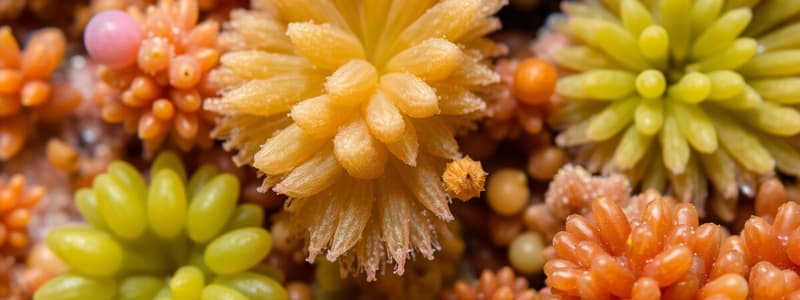Podcast
Questions and Answers
What is the defining feature of microbes?
What is the defining feature of microbes?
- They can be seen without a microscope.
- They all reproduce sexually.
- They are all multicellular organisms.
- They can only be seen with a microscope. (correct)
Which type of algae is primarily found in freshwater environments?
Which type of algae is primarily found in freshwater environments?
- Rhodophyta
- Phaeophyta
- Chlorophyta (correct)
- Diatoms
What characteristic is common to bryophytes?
What characteristic is common to bryophytes?
- They lack true vascular tissue. (correct)
- They grow exclusively in deserts.
- They reproduce using seeds.
- They have true roots, stems, and leaves.
What distinguishes pteridophytes from other plant groups?
What distinguishes pteridophytes from other plant groups?
Which of the following is a feature of fungi?
Which of the following is a feature of fungi?
Which type of pteridophyte is characterized by jointed stems?
Which type of pteridophyte is characterized by jointed stems?
What ecological role do diatoms primarily serve?
What ecological role do diatoms primarily serve?
How many known species of algae exist?
How many known species of algae exist?
Flashcards are hidden until you start studying
Study Notes
Diversity of Microbes, Algae, Bryophytes, and Pteridophytes
Microbes
- Definition: Microbes are tiny organisms that can only be seen with a microscope.
- Types:
- Bacteria: Single-celled prokaryotes, diverse in habitat and function.
- Archaea: Prokaryotic microorganisms similar to bacteria but genetically distinct, often living in extreme environments.
- Fungi: Includes yeast, molds, and mushrooms; eukaryotic and can be unicellular or multicellular.
- Viruses: Non-cellular entities that require a host cell for reproduction.
- Diversity: Estimated millions of species, crucial for ecosystems (decomposition, nutrient cycling).
Algae
- Definition: Photosynthetic organisms found in various aquatic environments; can be unicellular or multicellular.
- Types:
- Chlorophyta (Green algae): Primarily freshwater; significant contributors to oxygen production.
- Rhodophyta (Red algae): Mostly marine; important for coral reef ecosystems.
- Phaeophyta (Brown algae): Marine; includes large forms like kelp.
- Diatoms: Unicellular, with silica shells; vital in aquatic food webs.
- Diversity: Over 30,000 known species; key role in carbon fixation and as food for various aquatic organisms.
Bryophytes
- Definition: Non-vascular land plants, including mosses, liverworts, and hornworts.
- Characteristics:
- Lack true roots, stems, and leaves; have simple structures called gametophytes.
- Require moisture for reproduction (flagellated sperm).
- Types:
- Mosses: Small, leafy plants, important for soil formation and water retention.
- Liverworts: Can be leafy or thallose; grow in damp environments.
- Hornworts: Have a horn-like structure for reproduction.
- Diversity: Approximately 20,000 species; important in habitats for stabilization, water retention, and biodiversity.
Pteridophytes
- Definition: Vascular plants that reproduce via spores; includes ferns, horsetails, and clubmosses.
- Characteristics:
- Possess true roots, stems, and leaves; have vascular tissue for fluid transport.
- Do not produce flowers or seeds; reproduction occurs via spores.
- Types:
- Ferns: Most diverse group; have fronds and play key roles in various ecosystems.
- Horsetails: Characterized by jointed stems with whorled branches; often found in wet areas.
- Clubmosses: Ancient lineage; resemblance to moss but more closely related to ferns.
- Diversity: About 12,000 species; contribute to forest understory and serve as habitat for wildlife.
Conclusion
Understanding the diversity of microbes, algae, bryophytes, and pteridophytes is crucial for appreciating ecosystem functions and the evolutionary relationships among different life forms. Each group plays a significant role in the environment, from nutrient cycling to habitat formation.
Microbes
- Tiny organisms only visible with a microscope.
- Include bacteria, archaea, fungi, and viruses.
- Bacteria are single-celled prokaryotes, diverse in habitat and function.
- Archaea are prokaryotes similar to bacteria but genetically distinct, often found in extreme environments.
- Fungi are eukaryotic, including yeast, molds, and mushrooms, can be unicellular or multicellular.
- Viruses are non-cellular entities that require a host cell for reproduction.
- Millions of microbial species are estimated, essential for ecosystem functions like decomposition and nutrient cycling.
Algae
- Photosynthetic organisms found in various aquatic environments.
- Can be unicellular or multicellular.
- Chlorophyta (green algae) are primarily freshwater and significant oxygen producers.
- Rhodophyta (red algae) are mostly marine and important for coral reef ecosystems.
- Phaeophyta (brown algae) are marine, including large forms like kelp.
- Diatoms are unicellular with silica shells, crucial in aquatic food webs.
- Over 30,000 known algal species play a key role in carbon fixation and serve as food for various aquatic organisms.
Bryophytes
- Non-vascular land plants including mosses, liverworts, and hornworts.
- Lack true roots, stems, and leaves, have simple structures called gametophytes.
- Require moisture for reproduction due to flagellated sperm.
- Mosses are small leafy plants important for soil formation and water retention.
- Liverworts can be leafy or thallose and grow in damp environments.
- Hornworts have a horn-like structure for reproduction.
- Approximately 20,000 bryophyte species contribute to habitat stabilization, water retention, and biodiversity.
Pteridophytes
- Vascular plants that reproduce via spores, including ferns, horsetails, and clubmosses.
- Possess true roots, stems, and leaves, have vascular tissue for fluid transport.
- Do not produce flowers or seeds, reproduction occurs via spores.
- Ferns are the most diverse group, have fronds and play key roles in various ecosystems.
- Horsetails are characterized by jointed stems with whorled branches, often found in wet areas.
- Clubmosses are an ancient lineage, resembling moss but more closely related to ferns.
- About 12,000 pteridophyte species contribute to forest understory and serve as habitat for wildlife.
Studying That Suits You
Use AI to generate personalized quizzes and flashcards to suit your learning preferences.



